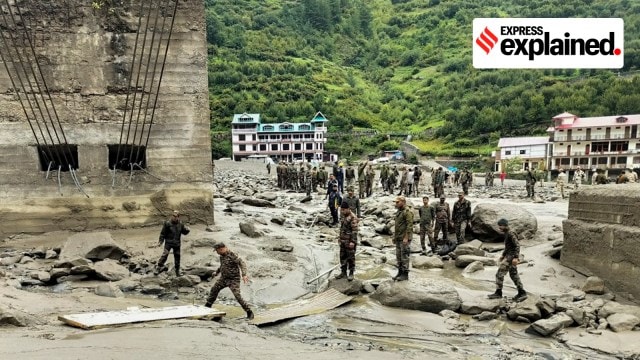Rescuers say there is 50-60 feet of muck, almost like quicksand, at the site, which is near-impossible to move without heavy machinery. With two bodies retrieved so far, and an estimated 60 missing, the rescuers are at a critical juncture.

The Commandant of the State Disaster Response Force, Arpan Yaduvanshi, said that communication with their ground team has been patchy as they are relying entirely on satellite phones.
“This gets worse due to deteriorating weather. Though we have dispatched four helicopters, one has reached Harsil helipad, and the supplies with six personnel will reach Dharali on foot, four kilometres away,” he said.
Why is the Dharali route inaccessible?
The local administration and the rescuers have been stuck at various points on the Gangotri highway, such as Netala and Bhatwari, where landslides have damaged the road to the village. Dharali is 20 km from the nearest sub-district headquarters of Bhatwari. The alternative is air travel, but the helipad closest to Dharali is in Harsil, four kilometres away.
“Our personnel will have to traverse this distance on foot as road connectivity has been blocked. Heavy machinery has not reached the spot yet because of this. We need Chinook helicopters for ferrying excavators, earthmovers, and other equipment,” Yaduvanshi said.
The Chinook, a heavy-lift tandem-rotor helicopter known for its transport capabilities, is designed to carry large loads, including up to 55 troops and a cargo of up to 10 tonnes. A mini excavator can be transported by such choppers.
Story continues below this ad
However, monsoon season is considered no-fly time as Uttarakhand’s weather is not conducive for helicopters. One of the SDRF helicopters had to return due to inclement weather. During the season, chartered helicopters and shuttle services are also temporarily suspended.
Equipment needed
SDRF personnel carry a rotary rescue saw, a thermal imaging camera for use in darkness, a victim-locating camera designed to find those trapped under debris during natural calamities, pelican lights, and portable generators.
Yaduvanshi said the victim-locating camera has a microphone, speaker, and lighting system to locate and communicate with individuals trapped in collapsed structures and confined spaces. These cameras are mounted on a probe, which is then inserted into tight spaces, allowing rescuers to visually assess the situation.
The rescuers’ mobility is impeded by the quicksand-type soil. “They are using plywood and other sturdy structures to move around. The team on the ground has been using shovels. Though there has been a let-up in the rain, this is not enough,” Yaduvanshi said. Satellite phones of the personnel are either outside network coverage or running out of battery.
Long op ahead
Story continues below this ad
Authorities say it might take a week before they fully unearth the extent of the calamity. Vinod Kumar Suman, secretary of disaster management, said that they have sought helicopters from the Centre. “We have sought Mi-17 helicopters along with Chinook. Two are on their way from Chandigarh and Sarsawa. We have also reached out to New Delhi for modern technology like ground penetrating radars to help with the rescue,” he said.
Suman said that the reason for the floods remains unclear.
Yaduvanshi, who supervised the Uttarkashi tunnel collapse, said that though it was a difficult task, due to the terrain and fragility of the rock, there was optimism in that operation because they could establish a connection with the people stuck inside.
“However, though the scale could be called somewhat similar, the absolute blackout of information from under the debris this time is concerning. Technically, the tunnel collapse proved challenging, but the obstacle here is the inability to press technology and manpower into service,” he said.








































